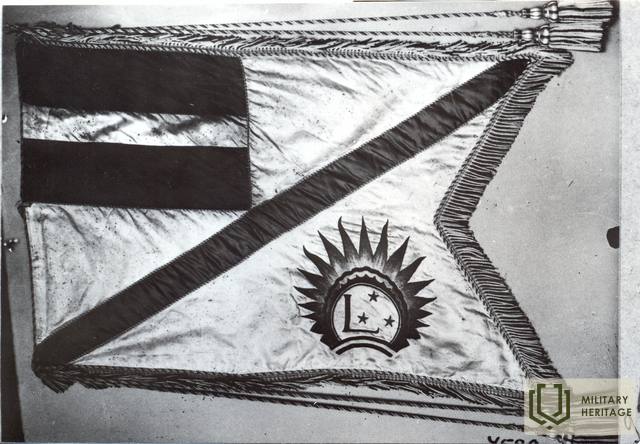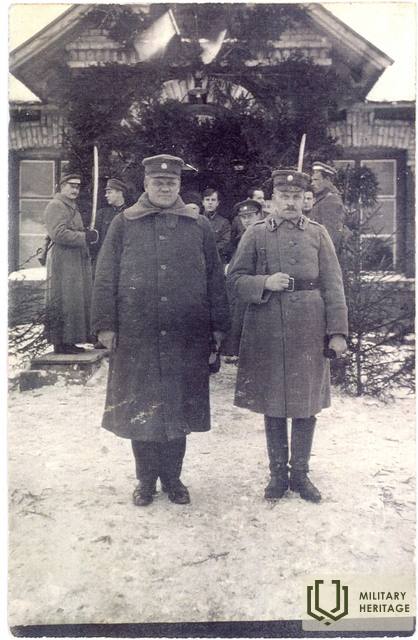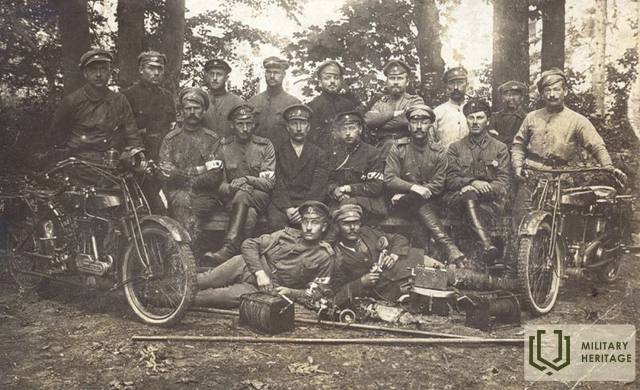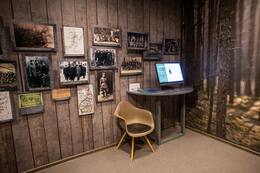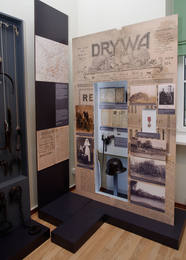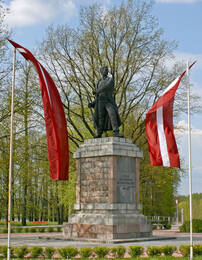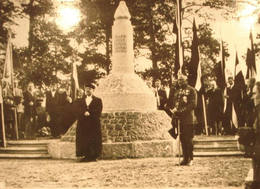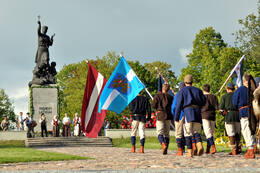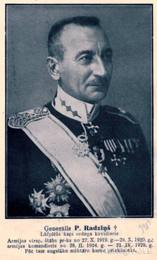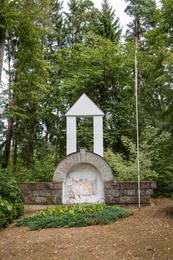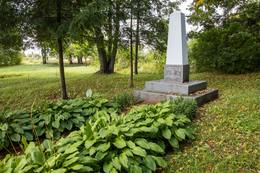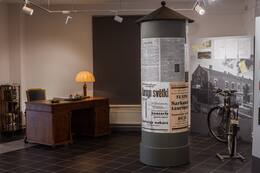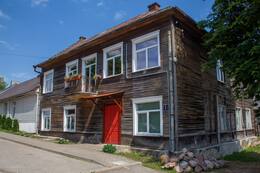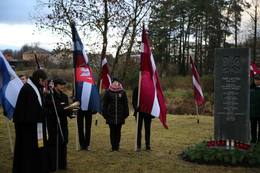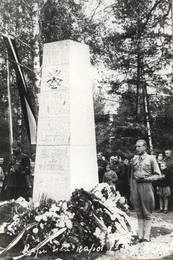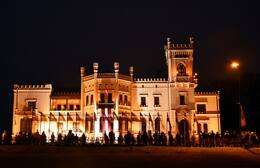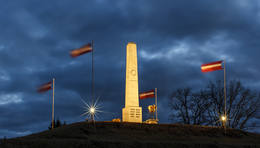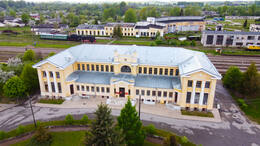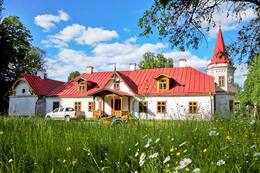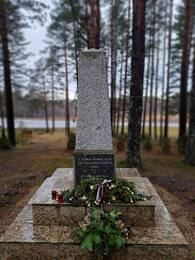Liberation of Latgale from the Bolsheviks
I Wars of Independence
After the victory over Pavel Bermont's forces, the Latvian government decided on an operation to liberate Latgale, which needed the support of neighboring countries. After unsuccessful talks with Lithuania at the end of December, the Supreme Command agreed to co-operate with the Polish army. On January 3, 1920, Polish and Latvian forces attacked South Latgale, liberating Daugavpils, and on January 9, the Latvian army liberated Latgale until the beginning of February.
At the time of the liberation of Latgale, the Commander-in-Chief of the Latvian Army was General Jānis Balodis, and the Chief of Staff of the Commander-in-Chief was Colonel Pēteris Radziņš. The Daugavpils capture operation was led by Polish General Edward Ridge-Smigli. The liberation of Rēzekne and the central part of Latgale was led by the commander of the Kurzeme division, Lieutenant Colonel Jānis Puriņš. The liberation operation in northern Latgale was led by the headquarters of the Latgale Division in Vecgulbene, led by Colonel Krišjānis Berķis.
At the same time, at the beginning of January 1920, a delegation of the Latvian Red Cross went to Moscow to conclude the ceasefire, which was signed on January 30 (entered into force on February 1). Peace talks began in Moscow on April 16, but continued in Riga over the summer, depending on events on the Soviet-Polish front. The peace treaty was signed in Riga on August 11, 1920.
In April and May 1920, the newly formed Zemgale division joined the army on the Latgale front, while in the middle of April the Polish army left Latvia, remaining only in Daugavpils. It was forced to leave the city in early July as a result of the Red Army's offensive. Then Latvian forces took over part of the present-day town of Grīva (then a separate town on the left bank of the Daugava) and six parishes of Ilūkste district, which had been declared to belong to Poland. Already after the peace was concluded in the beginning of September 1920, the 12th Bauska Infantry Regiment and other units repressed Lithuanian army units in the Subate district, but in October the Latvian army occupied the last parishes of Ilukste district, which were left by the Lithuanian army.
More information sources
Eric Jacobson. Latvian War of Independence. The struggle of the Provisional Government of Latvia and its armed forces to ensure the independence of Latvia on November 18, 1918 - August 11, 1920. - National Encyclopedia: https://enciklopedija.lv/skirklis/22216-Latvijas-Neatkar%C4%ABbas-kar%C5%A1
Juris Ciganovs. The liberation of Latgale in 1920 marked the end of Latvia's War of Independence. SARGS.LV, 03.01.2020. https://www.sargs.lv/lv/latvijas-neatkaribas-kars/2020-01-03/latgales-atbrivosana-1920-gada-iezimeja-latvijas-neatkaribas
Liberation of Latgale. Wikipedia. https://en.wikipedia.org/wiki/Latgales_atbr%C4%ABvo%C5%A1ana
North Latgale liberation operation. Wikipedia. https://en.wikipedia.org/wiki/Zieme%C4%BClatgales_atbr%C4%ABvo%C5%A1anas_oper%C4%81cija
Related objects
Exhibition "Ziemeļlatgale in the freedom struggle" in Balvu County Museum
The exhibition allows you to look into the history of Latvian Independence from the point of view of Northern Latgale. What is the contribution of the people of our side, how did our grandfathers get involved in the fight for the common cause of Latvia, what are their fates, how is their memory preserved? Answers to these and other questions can be found in Latvian, Russian and English.
The Northern Latgale liberation operation, also called the Viļakas-Jaunlatgale capture operation, was part of the Latgale liberation attack operation carried out by the Latvian armed forces during the Latvian freedom struggle. Its purpose was to occupy the northern part of Latgale and cut the Pskov-Daugavpils railway line in order to prevent the arrival of additional units of Soviet Russian troops from the Estonian front and from inside Russia. The most important battles took place between January 9 and 20, 1920, when control over the railway line from Pitalova (Abrene) to Kārsava was gained.
Preiļi Museum of History and Applied Art exhibition "Museum stories for Latvia"
It is located in the premises of the Preiļi Cultural Center.
Preiļi Museum of History and Applied Art (PVLMM) exhibition "Museum stories for Latvia" about the First World War, the War of Independence and the Second World War can be viewed.
The "Story of Drywys" section of the exhibition "Museum Stories for Latvia" (opened in 2018) of the Museum of Preiļi History and Applied Arts is dedicated to the First World War, the War of Independence and the liberation of Latgale, as well as to the knights of the Lāčplešana War Order. The exhibition section "The story of the flag" tells about the difficult events of the Second World War period, during which the people of Preila were affected by deportations, the Holocaust, involvement in the military units of the warring parties, and after the war - in the ranks of national partisans. The "Righteous Among the Nations" medal awarded to Vladislav Vuškānas, the savior of the Jews from Preiliat, can also be viewed.
Upon prior application, a tour is available in Russian and English.
Monument to the fallen soldiers of the Latgale partisan regiment 1919 - 1920
A monument dedicated to the Latgale partisan regiment.
In the history of the War of Independence of Latvia (1919-1920), the Latgale partisan regiment, whose cradle was once in the territory of the former Balvi district, was formed from the "green" regiments already at the end of 1918.
The monument was opened for the first time on August 14, 1938, with the participation of General Jānis Balodis. The author of the monument is the artist Kārlis Jansons.
In 1940, the communists destroyed the monument, after the establishment of Soviet power, the executive committee of Abrene district decided to demolish the monument in the spring of 1941, but the image of the partisan was buried in the courtyard of the Balva militia. During the German era, the monument was restored, but when the Red Army returned, the monument was torn down a second time, taken away and destroyed. When Latvia regained its national independence, the people of Balveni collected donations for the restoration of the Latgale partisan monument. On November 11, 1993, the restored monument of Andrej Jansons, the son of the artist Kārļis Jansons, was unveiled at Balvos.
A monument to the soldiers who died in the battles for the liberation of Latvia in Jaškov
The road section Viļaka – Vientuļi (P35) is on the left side of the road, near the chapel of the Jaškova grave.
Monument to Latvian and Estonian soldiers who died in the War of Independence.
The monument created by the sculptor Kārlis Zemdega in 1920 in memory of the soldiers who fell in the Freedom Struggle in Jaškov was first unveiled on September 22, 1935 at the graves of the Viļaka brothers established in 1929.
The struggle for freedom against the Red Army in Viļakas district began with the attack of the Latvian army and the Latgale partisan regiment on January 9, 1920. Estonian soldiers also participated in it. Viļak was liberated already on January 9, but the fighting to the east of it continued for several more days. Both before and after the liberation of Vilakas, the fallen soldiers were buried in different places known to local residents. As the state of Latvia stabilized, Viļakas began to think about setting up joint graves of brothers. Already from November 18, 1923, after a solemn service in the Catholic church, held by dean P.Apšinīks, a large procession went to the newly formed burial place of the brothers on the hill, in the so-called Jaškov - in the immediate vicinity of Viļaka. Soon, the foundation of the monument was built, the collection of donations for the monument began. Identifying the graves of the fallen soldiers took time, only on November 3, 1929, the reburial took place in the future graves of the brothers. The 31 Latvian and 14 Estonian soldiers who fell in the vicinity of Viļakas were buried in them. In 1935, the monument was ready and on September 22, it was solemnly consecrated.
In the pre-war years of Latvia's independence, all important national events in Viļaka parish were connected with the brothers' graves and this monument.
The monument was destroyed during the post-war years of Soviet rule, but its granite parts, although damaged, were preserved. The monument was restored on November 11, 1990 - Lāčpleš Day.
Monument “Vienoti Latvijai” (“United for Latvia”) or Māra of Latgale
The Monument “Vienoti Latvijai” (“United for Latvia”) or Māra of Latgale is located in Rēzekne. Its central image of a woman holding a cross in her hand symbolises the Latgale region of Latvia, which was liberated from Bolshevik rule in 1920, and its spirit of Christian civilisation. The monument was initiated by public figures of Latgale in the 1920s. The foundation stone was laid and consecrated on 8 June 1930. In June 1934, a competition for the design of the monument was announced, and the design by Kārlis Jansons won the com petition. The monument was unveiled on 8 September 1939, and the consecration service was held by Bishop Jāzeps Rancāns. After the Soviet occupation in November 1940, the monument was pulled down. The bronze sculptures were not destroyed due to a shortage of time and the monument was restored on 22 August 1943, during the German occupation. When the Soviet occupation returned, the cross was initially sawn off, while, in 1950, the monument was completely destroyed.
During the Soviet occupation, a Lenin monument was erected instead, which was removed immediately after Latvia regained its independence in 1991. During the Awakening in 1989, the idea of restoring the historical United for Latvia monument was born. The monument was re created by the sculptor Andrejs Jansons, the son of Kārlis Jansons, in collaboration with Inta Folkmane, based on his father’s materi als and photographs. The restored monument was unveiled on 13 August 1992, during the First World Gathering of Latgalians.
Memorial place of General Pēteris Radziņš
Located in Valka parish, driving on the road Valka - Rūjiena (P22) 4 kilometers, to the right, following the signs.
Pēteris Radziņš was born on May 2, 1880 in Lugavis Parish, Jaunvīndedze. Studied at Lugaži Parish School, Valka City School and Valka Nelson Real School. Joined the Russian army as a volunteer. In the autumn of 1919, he returned to Latvia and on October 27 was appointed Chief of Staff of the Commander-in-Chief of the Army, assuming this position at a time when the Bermontians were threatening Riga. As the chief of staff, he has led all the battles of Riga, Zemgale and Latgale. Promoted to General on February 5, 1920.
Today, a memorial stone dedicated to General Pēteris Radziņš (1880 - 1930) can be seen near the family house.
On November 11, 2017, a memorial plaque to Pēteris Radziņš was unveiled in Riga, at the corner of the Daugava gate.
Video: Memorial event of General P. Radziņš in Riga Brothers Cemetery in 2019
Video: On May 2, 2019, on the 139th birthday of General Pēteris Radziņš, a commemoration event took place on the embankment of November 11, near the Presidential Palace, covering the memorial plaque to the guard of honor and those interested.
The exposition of Valka Local History Museum “Valka - the cradle of Latvia's independence” also reflects the life and work of General Pēteris Radziņš.
In addition to the traditional ways of displaying the collection, the exhibition uses interactive multimedia solutions. Information and annotations translated into Estonian and English.
Monument to the soldiers of the 1st Liepaja Infantry Regiment at the battlefield of 1919
Located in Madona district, Murmastiene parish, Meža Strodu village, 6 km from Varakļāni.
A monument to the Freedom Fights can be seen at the battlefield of the 1st Liepaja Infantry Regiment, where in 1919 they fought against the "red" army. Not far from this place, Aleksandrs Lakstīgala, a countryman, was seriously wounded in the battle. A dead man was found near his home. Therefore, the location of this monument was chosen.
On August 16, 1936, the granite Victory Monument (it was called in the press of that time) was unveiled to commemorate the Freedom Fights, engraved with the words: “1. every corner of our homeland - so now ours. ” It was installed by the leadership of the Rēzekne Guard Regiment, consecrated by the senior pastor of the Rēzekne Guard Regiment Vincents Tomašūnas with the local parish dean Kalinka. The opening debts were accepted by Žanis Bach, the commander of the Zemgale division and a knight of the Lāčplēsis Order. In 1950, it was demolished and destroyed. On November 16, 1996, the restored monument was inaugurated, also in honor of the 78th anniversary of the proclamation of the Republic of Latvia.
Exposition "Latvian Army in Pļaviņas in the 20th Century"
Located at Odzienas Street 2, Pļaviņas.
The permanent exposition "Latvian Army in Pļaviņas in the 20th Century" can be seen.
The building in Pļaviņas, Odzienas Street 2, has a long history - from the time when Stukmaņi wholesaler Hugo Apeltofts started active economic activity in it, thus promoting the development of Pļaviņas city, until the headquarters of the Latvian Eastern Front was established here during the War of Independence. In 1919, the activities of Latvian army units against the Red Army in Latgale were commanded directly from Pļaviņas.
In 1934, a memorial plaque was unveiled near this house with the inscription: "In 1919, the headquarters of the Eastern Front was located in this house, and here General Jānis Balodis took over the command of the Latvian National Army." It was removed and destroyed by the Soviets in 1940, but on June 16, 1990, with the support of the LNNK Plavinas branch, it was restored.
Now, next to the former headquarters building, there is a memorial stall dedicated to 15 cavalry of the Lāčplēsis Military Order born in Pļaviņas region. In Pļaviņas, as well as provides an insight into the life stories of the Knights of the Lāčplēsis War Order.
Not far from the exposition building is the Latgale Division headquarters building, which was built in 1913 by Count Teodors Medems as a Stukmaņi liqueur factory. In 1919 it was taken over by the regime of P. Stučka, where it had also established a prison. After the expulsion of the Bolsheviks, in 1925 the building was taken over by the Latvian Army, which housed the headquarters of the Latgale Division. 10 generals and other officers of the Latvian Army spent their military careers in this building. In 1940, the building was taken over by the Red Army. In the post-war years, it housed a school as well as a municipality. Around 1970, the building was started to be used by the production association "Rīgas Apīrsbs".
Visits to the exhibition must be booked in advance by calling T. 28442692.
Exposition “Abrene Rooms”
The exhibit ‘Abrene Rooms’ is located near the city centre of Viļaka. It covers the period from 1920 to 1960 when Viļaka was part of Jaunlatgale, Abrene district, and became the centre of Viļaka district and Abrene municipality. The exhibit is located in the building with the most interesting and diverse history in Viļaka. Initially located on the old Marienhausen Market Square, it later housed apartments, offices and various shops and, during World War II, the Latvian Self-Defence headquarters, the Gestapo and also the Cheka. The exhibit features items from the national partisan camp in the Stompaki Bog, which are related to the national partisan movement in the Latgale region, as well as documents and photos associated with the War of Independence. With a guided tour booked in advance, the owner, Dzintars Dvinskis, will present the testimonies available in the exhibit.
In 2023, an exhibition for military heritage in Northern Latgale was created.
Memorial stele for the knights of the War Order of Lāčplēš
It is located next to the Roman Catholic Church of the Heart of Jesus in Viļaka.
The memorial stele for the knights of the Lāčplēš War Order in Viļakas region was opened on November 11, 2017. The destinies of 28 Lāčplēš Knights of the Military Order are connected with the name of Viļakas county.
The granite stele was created as part of the project "Remember Lāčplēšus" dedicated to the centenary of the Latvian state. Commemorative stelae of a uniform model will be installed throughout Latvia in honor of the soldiers who died in the Latvian Freedom Struggle. The initiator of the project is the Jaunsardze and Information Center.
Five knights of the Lāčplēš War Order, whose names are engraved on the memorial stele, lived in the territory of the present-day Viļakas district after the end of the Freedom Struggle:
– Jānis Kuļšs was a young farmer in Apsīs, Šķilbēni parish,
– Aleksej Lyubimov (Lavrentiev) lived on the Fortepianova farm in Šķilbēni parish, later in Vilaka,
– Teodors Mende managed the farm assigned to him and was a forest guard in the village of Katleši, Žigur parish,
– Eduard Tennyson lived at Vecumu station, later lived in Chabatrova village and worked at p/s "Viļaka",
– Jānis Burmeisters after 1928 lived in Šķilbēni parish for some time.
The brothers' cemetery in Viļakas county is the resting place of 45 soldiers who gave their lives in 1920, defending Latvia from bigots. January 9 was the day when the attacks began in North Latgale, and despite the difficult weather conditions at that time, Viļaka was also liberated on the same day.
In the battles for the liberation of Latgale, Estonian soldiers also fought side by side with Latvian army soldiers and partisans against the Red Army in Viļakas county. Many of them gave their lives for a free Latvia.
Alūksne Museum
The Alūksne Museum is located in an architectural monument of national significance: the neo-Gothic Alūksne New Castle built in the late 19th century. The museum features an exhibition named ‘Memorial Room for Victims of the Totalitarian Regime’, which tells about the fate of the inhabitants of Alūksne municipality in Siberia and the Far East, while the time periods from prehistory to the present meet in the Alūksne history exhibit ‘Feast of the Ages’. It features a separate section devoted to the contribution of the 7th Sigulda Infantry Regiment to the military, culture and public life. The formation of the 7th Sigulda Infantry Regiment began on 20 June 1919 in the Naukšēni Manor. Initially, a battle group of 22 officers and 1,580 soldiers was formed from the reserve battalion of the Northern Latvian Brigade, and was named the Dankers Division. It was included in the 2nd Battalion of the 3rd Jelgava Regiment. On 23 August, following an increase in the number of companies, it became part of the 7th Sigulda Infantry Regiment. Having taken part in the battles against Bermondt, on 5 January 1920, the regiment was transferred to the Latgale front to fight the Bolsheviks. After the signing of the Peace Treaty with Soviet Russia, the regiment guarded Latvia’s eastern border. The Latvian War of Independence saw the deaths of more than 200 soldiers of the regiment, while 85 were awarded the Lāčplēsis War Order. In 1921, the 7th Sigulda Infantry Regiment was stationed in Alūksne. The regiment’s headquarters were set up in the Alūksne New Castle. After World War II, the castle was taken over by Soviet security institutions. As of the late 1950s, the castle housed various cultural institutions: the Culture and Cinematography Department of the Executive Committee, a pioneer house, a library, a cinema and a museum.
Monument to the soldiers of the 7th Sigulda Infantry Regiment who died in the Latvian War of Independence
Located on the shores of Lake Alūksne, on the edge of Pleskavas Street (Kolberg Road).
On June 22, 1923, the President of Latvia, Jānis Čakste, unveiled a monument to the fallen soldiers of the 7th Sigulda Infantry Regiment. The monument is based on the design of the artist Jūlijs Miesnieks.
The soldiers of the regiment also improved and maintained the area around the monument. Soldiers gathered at the monument on the eve of the regiment's annual holiday, when the holy fire was lit, as well as on the day of the regiment's year after the parade and intercession in the garrison cemetery.
1940/1941 The Bolsheviks removed and destroyed the plaque in 1953, but the monument itself was demolished in 1953 and its stones were laid in the foundations of the corner of the barracks house.
At the beginning of the Awakening, in the autumn of 1989, the vicinity of the destroyed monument, which was still in the territory of the USSR occupation forces, was cleaned up. On November 11, a temporary granite memorial was unveiled at the former location of the monument, with the text: "The monument of the 7th Sigulda Infantry Regiment will be restored in this place on November 11, 1989."
Thanks to the initiative of U. Veldre, the head of the Alūksne Brothers Cemetery Committee, the restoration of the monument was started and on October 16, 2009 the restored monument was unveiled.
Unlike the original monument, a cross was created on the obelisk regiment instead of a chest sign. Both sculptures of the monument were wrought by the sculptor Ainars Zelcs. Both the part of the 22 original obelisk blocks found on the territory of the National Armed Forces Infantry School and the newly built blocks were used for the restored monument.
On June 20, 2019, as part of the centenary of the Sigulda Infantry Regiment, a memorial site and a granite memorial plaque to the fallen soldiers of the unit were unveiled at the foot of the monument hill. The memorial site was built with funds donated by the staff of the Infantry School of the National Armed Forces.
Gulbene Railway Station
The Gulbene Railway Station is located in the city of Gulbene. During World War I, in 1916 to 1917, the narrow-gauge railway line to Pļaviņas was reconstructed to 1,524 mm width to ensure that it can serve as a connection to the Rīga-Daugavpils line. In addition, a railway line to Ieriķi and to Sita was constructed, thereby establishing a connection with Pytalovo. As a result, Gulbene became a railway hub. The current station building by architect Pēteris Feders was constructed in 1926. During the War of Independence, on 31 May 1919, when Gulbene was liberated from the Bolsheviks, the 1st (4th) Valmiera Infantry Regiment collected a significant number of war trophies here. On 14 June 1941, both civilians and Latvian Army officers arrested in the Litene Summer Camp were deported from the Gulbene Railway Station. As a key hub, it was bombed in the spring of 1944. After the war, it was restored to its original form. An educational and interactive centre named ‘Railway and Steam’ was opened in 2018. Next to the Gulbene station is the company SIA Gulbenes – Alūksnes bānītis, which offers interactive lessons and tours. Visitors have access to the station building and platform, a memorial plaque and a monument to the repressed ones by sculptor Indulis Ranka.
Arendole Manor
Arendole Manor was first mentioned in historical sources in the 16th century. Over the course of time, the owners of the manor have changed several times. The manor has belonged to the Grappenbruck, Lydinghausen-Wulf and Plater-Zyberk families. The manor house received its current look during the reconstruc tion between 1895 and 1901.
On 14 January 1921, on the basis of the agrarian reform law, the manor was expropriated and put at the disposal of the Kalupe Parish Board. The landlord house building of the manor was renovated and, in 1925, a primary school and an orphanage were founded there, while the home for the disabled of the war was established in the building of the servants’ house. The school and the home for the disabled were operating until 1975. In 1995, the building of the Arendole Manor landlords was pur chased by private owners and its restoration began. Since 2002, the association “Es Latgalei” (I am for Latgale) has been oper ating at the manor, which is taking care of its preservation and development. The visitors to the manor have the opportunity to see the reno vated premises and get acquainted with the largest collection of ancient objects in Latgale, as well as to learn about the histori cal events of the 20th century in Latgale. A special exhibition is dedicated to Jānis Babris, the former policeman of Kalupe Parish (1904–1982), who, on 14 June 1941, resisted a deportation task force, shot a militia operative, Slics, and wounded Communist Party plenipotentiary, Jozāns. Arendole Manor offers overnight stays and rental space for vari ous events.
Monument to the Latvian Freedom Struggles at the site of the battles of the 3rd Jelgava Infantry Regiment
Monument to the 3rd Jelgava Infantry Regiment's January 16, 1920, freedom struggle in Latgale. With the inscription: “The place of the 3rd Jelgava Infantry Regiment's battles, the victory march through Latgale. 1920.16.I. We brought the sun, freedom and independence to Latvia”
The monument was unveiled in 1936. On August 16, General Žanis Bachs (1885–1941) consecrated it by Pastor Ādams Vizulis (1891–1970). The author of the monument's design was Engineer Zilēvičs.
The Latvian War of Independence (1918–1920) operation to liberate Latgale began on January 3, 1920. By mid-January, the Latvian and Polish armies had liberated Daugavpils and most of southern Latgale up to the Dagda–Indra line from the Bolshevik forces that had seized power in Russia. On January 9, the Latvian army began its offensive in Northern Latgale, rapidly advancing towards the Kārsava and Pitalova stations.
In the middle between the two directions of attack remained the Bolshevik-controlled area around Varakļāni, Viļāni and Rēzekne. On January 20, Latvian army units began the operation to liberate Rēzekne. Rēzekne was liberated on January 21. The Latvian army, across the entire expanse of the Eastern Front, reached the border of Latvian-inhabited lands by the end of January. Already on February 1, Soviet Russia signed an armistice agreement with Latvia.
With the victory in the Battles of Latgale, Latvia's eastern border was secured and the opportunity to annex Latgale to Latvia was gained. The Latvian army achieved the final unification and independence of Latvia in 1920.
The monument, dated 1920.16.I., is dedicated to the moment when the 3rd Jelgava Infantry Regiment took up its starting positions before the operation to liberate Rēzekne.
Related stories
Liberation of Northern Latgale from the Bolsheviks
On December 1, 1918, parts of the Red Army, based on the Red Rifle units, invaded the territory of Latvia. In order to protect their homes, families, native counties and escape from terror, the men around Balvi took up arms and went into the forests, and the first "green" groups began to form. In the spring of 1919, when the mobilization was announced, many men in the Balvi area were not allowed to fight in the Soviet Latvian army and they joined the "green" groups. Balvi, Silakrog, Rugāji, Teteru-Dūrupe and Liepna groups were formed. In the vicinity of Balvi, the activity of "green" groups became more active in March 1919.
In memory of Pēteris Radziņš, General of the Latvian Army, two-time Knight of the Lāčplēsis War Order
General Pēteris Radziņš, born in Lugka Parish, Valka District, in a simple farmer's family, where he learned to do field work. He was a very smart young man, after graduating from school he decided in favor of the war and it started his army rescue of Latvia from Bermont's troops. P.Radziņš was one of the most outstanding officers of the Latvian Army and was awarded with numerous Latvian and foreign orders and memorials.




